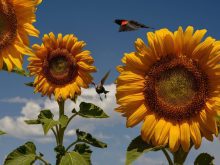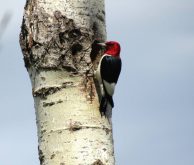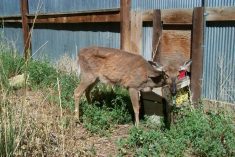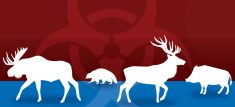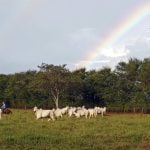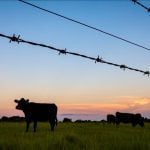Move over, snowy owl and Canada goose. A new rival is about to knock you off your national perch.
A two-year search by the Royal Canadian Geographical Society has nominated the gray jay as Canada’s national bird.
The choice has raised eyebrows in some quarters because the gray jay isn’t exactly a household name compared to more high-profile Canadian birds such as the common loon.
In fact, it didn’t even make the No. 1 spot among the five finalists vying for the title.
Read Also

Advance payment changes still mostly in waiting
APP cash advances for 2025 included a credit-worthiness change for farmers, but another three recommended updates for the federal farm lending program are still in limbo.
But the Royal Canadian Geographical Society insists the gray jay is the best choice because it embodies the Canadian spirit.
It’s found throughout Canada. It’s intelligent, tough, friendly, a bit mischievous and stays here all year round.
Just like a real Canadian, eh?
The society’s magazine, Canadian Geographic, revealed the choice recently. Currently, Canada does not have a national bird, although the beaver and the Canadian horse are officially designated national animals.
Aaron Kylie, the magazine’s editor, said his editorial team decided in 2014 to conduct a public campaign to select a national bird in time for the country’s 150th anniversary in 2017.
The project kicked off in January 2015 with a feature story, along with a website for Canadians to cast their ballots and provide reasons for their choices. Nearly 50,000 votes were cast online before the campaign closed August 31, 2016.
Before starting the campaign, organizers whittled the names of 450 birds native to Canada down to a short list of 40 before asking people to vote.
The top five finalists became subjects of a live debate held in September at the Canadian Museum in Ottawa where experts discussed the relative merits of each candidate. After that, a five-member expert panel made the final selection, taking all comments into consideration.
Kylie said the gray jay placed third in public votes. The common loon received the most, followed by the snowy owl. The Canada goose was fourth and the black-capped chickadee came in fifth.
But the judges settled on the gray jay because the common loon is already the provincial bird of Ontario. Quebec has the snowy owl and New Brunswick has the black-capped chickadee. (Manitoba’s provincial bird is the great grey owl.)
Kylie said it wouldn’t have been fair to give the title of national bird to one already claimed by a province. Which is why the number of votes cast wasn’t the only factor in making the final decision.
“For us, the vote was never intended to be the deciding factor for our determination,” Kylie said in an interview. “We don’t believe a national symbol should be decided by a popularity contest that’s held very unscientifically on a website.”
Besides, the gray jay has a number of unique characteristics which ranked it ahead of the other birds, he added.
For one thing, it is very intelligent. It has a body-to-brain ratio similar to that for dolphins and chimpanzees, considered among the most intelligent mammals.
For another, it is a boreal forest species found in every province and territory, making it truly national.
Also, unlike other birds, the gray jay does not migrate. It remains here year round, breeds and nests in the dead of winter and is known to hatch eggs in temperatures as low as -30 C.
Although not as physically imposing as some other birds, the gray jay is more striking than its name implies. Its grey feathers carry a brilliant sheen which shines like silver.
The bird was originally known as the Canada jay. But it underwent a name change in 1957 when the American Ornithologists’ Union, which standardizes the names of birds worldwide, renamed it. Hence the American spelling “gray” instead of “grey.”
Slightly smaller than the blue jay, the gray jay is commonly known by its nickname “whiskey jack,” an anglicization of the Cree word “wisakedjak,” meaning “mischievous prankster.”
That’s because it has a reputation as a camp robber who will snatch food from your picnic table or your plate when you’re not looking.
But it is also a very friendly bird known to be a companion of indigenous people and European explorers. It will even feed out of your hand if you let it.
In fact, Kylie said according to one (probably apocryphal) native legend, the gray jay will sometimes aid lost hunters by singing from tree to tree to lead them home.
Ken De Smet, a species-at-risk biologist with Manitoba Sustainable Development, said the gray jay can be found throughout Manitoba wherever there’s a boreal mixed forest environment.
“Anywhere you get a scattering of spruce, you start seeing a few of them,” De Smet said.
Of course, the Royal Canadian Geographic Society’s selection has no authority. Only the federal government can designate a national bird. But Kylie said Environment Minister Catherine McKenna, who attended the September debate, has expressed interest, as have several other federal cabinet ministers.
That’s because the nominee is smart, friendly, hardy, attractive, good natured and national, just like a good Canadian.
“It’s all the way,” said De Smet. “The only thing it doesn’t do is say ‘eh’ in its calls.”




